Toyota
Corolla Crankshaft Position Sensor Replacement Guide
How to change the crankshaft position
sensor on the 2ZR-FE 1.8L I4 engine in a 2009 to 2013 Toyota Corolla.
By Paul B. Michaels Author & Photographer Auto Mechanic Since 1989 |
||
 2010 Toyota Corolla S |
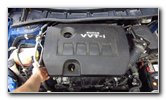 Pull Off Plastic Cover |
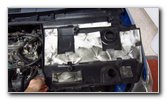 Engine Cover Removed |
| This automotive
maintenance tutorial was specifically written to assist owners of the 10th
generation (2009, 2010, 2011, 2012 and 2013) Toyota Corolla
in changing a failing or faulty crankshaft position sensor (also known by
the acronyms CKP, CKPS or CPS) on the 2ZR-FE 1.8 liter inline four cylinder
engine. Owners of other Toyota, Lexus or Scion vehicles such as the Yaris, Matrix, Prius, Camry, RAV4, Sienna, Tacoma, Tundra, FJ Cruiser, Venza, Highlander, Avalon, Sequoia, Land Cruiser, Allion, Premio, Auris, IS 250, ES 350, GS 350, tC, xB, xD, iQ and FR-S may also find these DIY instructions to be helpful. The most common symptoms of a failing or faulty crankshaft position sensor include stalling, difficulty starting, poor acceleration, reduced fuel economy (lower MPG), misfiring, vibrations, rough idle, backfiring, tachometer (RPM gauge) malfunction and a CEL / SES (check engine / service engine soon) warning light on the gauge cluster. If you have an OBDII Scanner (also known as an OBD2 scan tool), some of the related DTC (diagnostic trouble codes) you might see include the following: P0315, P0335, P0336, P0337, P0338 and P0339. The OEM (original equipment manufacturer) sensor in this 2010 Corolla S was part number Toyota 90919-A5004 (also known as part # 90919A5004). I highly recommend buying the original Toyota unit, but here are a few compatible replacement aftermarket sensors with their part numbers: Beck Arnley 180-0713, Holstein 2CRK0262, Walker 235-1404 and Standard Motor Products PC819. The tools needed to complete this procedure include a lug nut wrench, a floor jack, two jack stands, a flat head screwdriver, a 10mm socket and a 1/4" drive ratchet. If you also plan on checking or changing the camshaft position sensors, pull off the plastic engine cover. Skip that step if you are only going to change the crankshaft position sensor. The first few steps are to drive the car on to a level surface, shift the transmission into "Park" and turn off the ignition. Engage the emergency / parking brake and place wheel chocks on both sides of the rear tires to prevent the vehicle from moving. Disconnect the negative battery cable by loosening the terminal nut in the counterclockwise direction with the 10mm socket and a 1/4" drive ratchet. Wrap the negative terminal in a small towel and tuck it away on the right side of the 12V automotive battery to help prevent accidental electrical contact. |
||
|
|
||
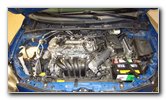 2ZR-FE 1.8L I4 Engine |
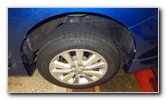 Front Passenger Wheel |
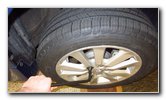 Slightly Loosen Lug Nuts |
| Slightly loosen the five lug nuts on the front passenger side wheel by turning them about 1/4 to 1/2 turn in the counterclockwise direction with the tire iron. | ||
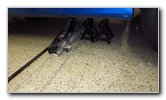 Raise Front of Car |
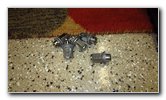 Five Lug Nuts Removed |
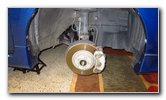 Wheel / Tire Removed |
| Raise the front
passenger corner of the car with the floor jack and securely support it with
at least two jack stands. Please do not solely rely on the floor jack to support the car! Spin off the five lug nuts and set them aside in a safe place. Carefully pull off the front passenger wheel and tire. Some home mechanics prefer to place the wheel and tire under the frame rail just in case the floor jack and two jack stands fail. |
||
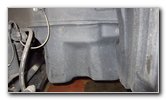 Plastic Engine Shield |
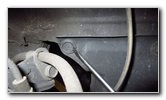 Pry Out Center Pop Rivet |
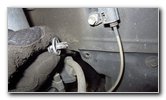 Plastic Fastener Removed |
| Locate the lower
black plastic engine shield or "splash guard" situated directly behind the
brake caliper and rotor. Use a small flat head screwdriver to pry out the smaller round center piece or "button" on the plastic pop rivet. Once the fastener has been unlocked, pry out the base of the pop rivet from the left side of the plastic panel. |
||
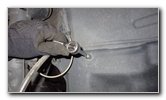 Loosen Counterclockwise |
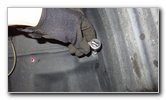 Loosen Second Screw |
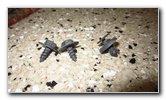 Two Bolts & Pop Rivet |
| Loosen the two
black metal screws by turning them in the counterclockwise direction with a
10mm socket and a 1/4" drive ratchet. Set the two screws and the plastic pop rivet aside in a safe place. |
||
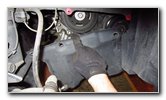 Lower Splash Guard |
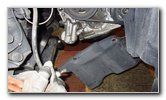 Passenger Side of Engine |
 Rear of 2ZR-FE 1.8L |
| Gently lower the
black plastic engine shield down towards the floor. You don't need to fully remove the cover. |
||
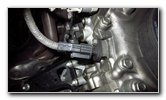 Crankshaft Position Sensor |
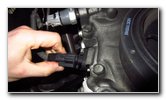 Push In Release Tab |
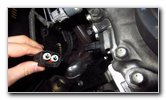 Pull Off Power Plug |
| Locate the large
black plastic electrical connector attached to the rear of the crankshaft
position sensor.
The crankshaft position sensor is located just below the oil pressure switch (also known as the oil pressure sender or oil pressure sending unit). Gently push in the release tab on the electrical connector before sliding it straight off the base of the old sensor. |
||
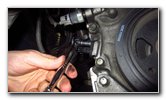 Loosen Single Bolt |
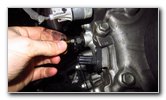 Turn Counterclockwise |
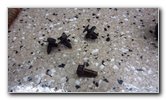 Sensor Bolt Removed |
| Loosen the single
bolt that secures the sensor to the rear of the engine by turning it in the
counterclockwise direction with the 10mm socket and a 1/4" drive ratchet. Set the bolt aside with the other fasteners. |
||
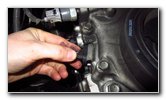 Gently Pull Out Sensor |
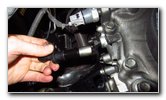 Old Sensor Removed |
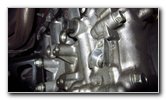 Clean Sensor Port |
| Gently rotate the
sensor back and forth a few times to loosen it from the engine. Pull the sensor straight out of the engine block. |
||
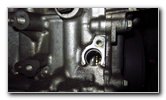 View of Crankshaft |
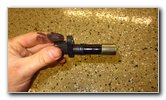 OEM Part Number |
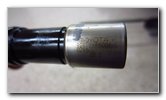 Toyota 90919-A5004 |
| Clean off the
"port" (opening) in the engine with a paper towel or a new shop rag. I highly recommend buying the genuine OEM sensor which is part number Toyota 90919-A5004. Inspect the old sensor for any metal shavings attached to the magnet on the end. My original crankshaft position sensor had a small amount of fine metal shavings on the magnet after 95,000 miles and 10 years. |
||
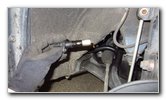 Line Up New Sensor |
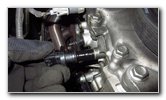 Insert New Sensor |
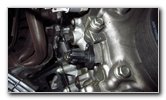 Line Up Bolt Holes |
| Line up the new
sensor with the opening in the engine.
Install the new sensor and line up the bolt holes. |
||
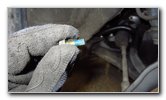 Loctite Blue Medium |
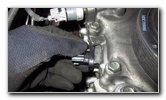 Spin Bolt Clockwise |
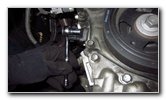 Tighten Bolt |
| Clean off any oil
or grease on the bolt with a paper towel. I chose to apply a small amount of Loctite Blue (medium - removable with hand tools) to the threads on the bolt. Spin in the bolt a few turns by hand in the clockwise direction to help prevent it from becoming cross threaded. Tighten the bolt in the clockwise direction with the 10mm socket and a 1/4" drive ratchet until it is snug. I had trouble locating the torque specification for the bolt in the service manual for the 2009 to 2013 Corolla, but the specification for the 2003, 2004, 2005, 2006, 2007 and 2008 Corolla is 80 lb-in or about 6.67 lb-ft (9 Nm). Double check that the bolt is tight before moving on to the next steps. Try to avoid over tightening the bolt to prevent from cracking the plastic sensor housing. |
||
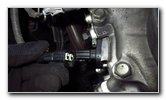 Push On Power Plug |
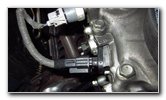 New Sensor Installed |
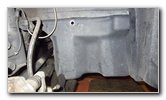 Raise Splash Guard |
| Slide the
electrical connector straight over the base of the new sensor. You should hear or feel the connector "click" securely into place. Raise the plastic engine shield back into place. |
||
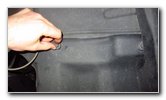 Spin In Two Screws |
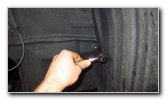 Tighten Clockwise |
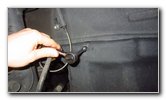 Tighten Rear Screw |
| Spin in the two
metal screws a few turns by hand in the clockwise direction to support the
plastic cover. Tighten the two screws in the clockwise direction with the 10mm socket and a 1/4" drive ratchet until they are snug. |
||
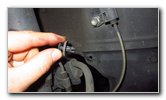 Plastic Fastener |
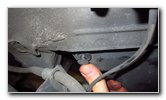 Push In Button - Secure |
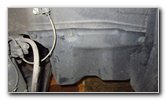 Engine Shield Secured |
| Make sure the
smaller round button in the center of the pop rivet is in the up and
released position. Insert the pop rivet and push in the button to secure the fastener in place. |
||
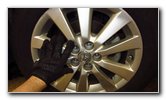 Push On Front Wheel |
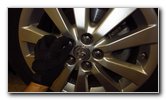 Spin On Five Lug Nuts |
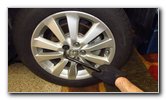 Slightly Tighten Lug Nuts |
| Carefully push the
front wheel and tire over the lug studs. Spin on the five lug nuts a few turns by hand in the clockwise direction to help prevent them from becoming cross threaded. Slightly tighten the lug nuts in a criss-cross or star pattern in the clockwise direction with the lug nut wrench. |
||
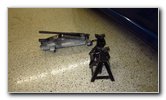 Lower Car From Stands |
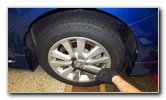 Torque Lug Nuts |
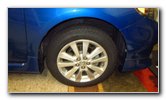 Sensor Change Complete! |
| Carefully lower the
car from the jack stands by using the floor jack. Continue tightening the lug nuts in the clockwise direction with the tire iron until they are snug. It would be best to use a torque wrench to tighten the lug nuts to the owner's manual specification of 76 lb-ft of torque. Please check out my other Corolla DIY tutorials at the links below - 2009-2013 Toyota Corolla Repair & Maintenance Guides |
||
| If you found this guide to be helpful,
please consider making a small donation by clicking on the PayPal.com
"Donate" button located to the right of this paragraph. Thank you!
(Note: I am not a registered charity. Donations are not tax deductible.) |

